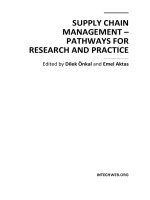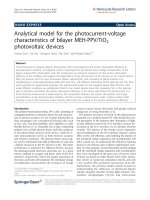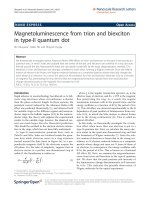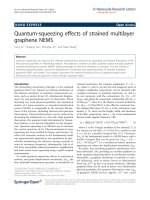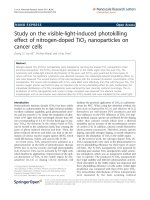Kakar et al. Pastoralism: Research, Policy and Practice 2011, 1:3 potx
Bạn đang xem bản rút gọn của tài liệu. Xem và tải ngay bản đầy đủ của tài liệu tại đây (7.8 MB, 9 trang )
RESEARCH Open Access
Rapid change of strategy is necessary for
development of dromedary camel pastoralism in
the Cholistan desert of Pakistan
Abdul Raziq Kakar
1*
, Kerstin de Verdier
2
and Muhammad Younas
3
* Correspondence:
1
Society of Animal, Veterinary and
Environmental Scientists (SAVES)
and Department of Livestock
Management, Faculty of Animal
Husbandry, University of
Agriculture, Faisalabad, Pakistan
Full list of author information is
available at the end of the article
Abstract
The Cholistan desert is part of the ancient Hakra River civilization, one of the oldest of
the Aryan settlers in the Indian subcontinent. It is one of the larg est deserts in Pakistan,
inhabited by around 1.2 million Rohi pastoral people practicing mobile livestock
husbandry. This production system is extremely important for food security and
conservation of livestock and landscap e. The camel is one of the important animal
genetic resources and about 80,000 are found in the desert. The main tribe with camel
herds is Marrecha. The desert pastoralists also raise goats, sheep and cattle breeds. The
major camel breed is Marrecha following by Brela. The precious camel genetic
resources are under threat due to commercial agricultural practices, land grabbing and
faulty development projects. The policies come from the top and pastoral peoples do
not participate in formulating strategies for devel opment. Hence the projects are not
supported by local livestock keepers and always result in failure. There is an urgent
need to save this pastoral livestock system, especially the camel breeds. It is suggested
that niche marketing, value addition, ecotourism and participation of pastoral people
in development policies may help achieve this goal. Organ ization of the livestock
keepers in the region can be an efficient tool to halt land grabbing
Keywords: Pakistan camel, pastoralists, land grabbing, biodiversity, value addition
Background
The pastoral people of the Cholistan desert move with their livestock year-round. They
travel in search of forage and water , stay some time and then move on. Generally they
use camels, donkeys and horses for moving. In the desert ecosystems, the pastoral peo-
ple prefer camels. which not only provides draft power for transporting goods but also
provides food in the form of milk w hen other livestock species cease milk production
in the dry and harsh seasons.
The pastoral livestock species are well adapted to the local ecology and produce under
very low input conditions. Pastoral livestock breeds are embodied with the indigenous
knowledge, aesthetic sense and cultural values of their keepers. The pastoral people have
been using their indigenous knowledge for breeding, feeding and health care in harmony
with the environment. In scenarios of climate change and global warming, the well-
adapted livestock species of the pastoral people assure food security (Raziq 2009b).
This system of livestock keeping is under threat due to many unfortunate circum-
stances. Though comprisi ng an important part of the local society, the pastoralists are
Kakar et al. Pastoralism: Research, Policy and Practice 2011, 1:3
/>© 2011 Kakar et al; licensee Springer. This is an Open Access article distributed under the terms of the Creative Commons Attribution
License ( , whic h permits unrestricted use, distribution, and reproduction in any medium,
provided the original work is properly cited.
still neglected when policies are being made for so-called development. It is strongly
believed that without the participation of the pastoral/indigenous people, the Millen-
nium Development goals of the United Nations cannot be achieved properly in the
regions where pastoral people live (Cordone et al. 2009). They are not properly valued
in the UN programmes and other donor agencies which make policies together with
national states. The policies affecting pastoral people must be formulated with t he
participation of these pastoral communities.
Cholistan desert
Cholistan desert is a part of the ancient Hakra River civilization, one of the oldest civi-
lization s of the Aryan settlers in the Indian subcontinent. Situated in southern Punjab
(latitudes 27° 42’ to 29° 45’ in the north and longitudes 69° 52’ to 75° 24’ in the east),
Cholistan is part of the Great Indian Desert and one of the largest deserts of Pakistan.
The total area of Cholistan desert is 10,399 square miles (2,693,328 ha). The tempera-
ture varies from 6°C to 50°C in w inter and summer respectively. The mean annual
rainfall varies from less than 100 mm in the west and 200 mm in the east (CDA 2009).
Most of the Cholistan is covered with a wide range of nutritious and drought tolerant
vegetation species.
The water sources available in the desert are comprised of the toba system and tube
wells provided by Cholistan Development Authority. A toba isapond,whererain
water is collected and used by all the inhabitants of the desert (Figure 1).
Pastoralists in Cholistan
Pastoralists provide services which are economically important to t he country. They
have developed and preserved unique breeds of livestock and traditional knowledge
Figure 1 A pond (toba) filled with water.
Kakar et al. Pastoralism: Research, Policy and Practice 2011, 1:3
/>Page 2 of 9
associated with them, and their lifestyle has developed the co-evolved ecosystem which
they have traditionally conserved and sustainably used.
The pastoral people have adopted a very good strategy to keep the livestock produc-
tion system viable. In the time of scarcity,theymovealongtheroadsandrailway
tracks towards the adjoining irrigated areas and rely on the vegetation available along
the water courses and road sides. Whenever they stop for temporary work as labourers
in the fields, their livestock browse the aftermath of the crops. Some pastoral herds
migrate from the Thal desert (in central Punjab of Pakistan) to Cholistan in August
and stay there for 5 months and then go back to Thal and the nearby irrigated areas.
The pastoralists kn ow the cu ltural events along their migratory routes and hence
they participate in the fairs (melas) to sell their male animals and milk. They also stay
near the peripheries of the cities to sell camel milk, which is usually mixed with buffalo
milk by middlemen. Usually the pastoral women sell the camel milk and the earnings
go to them (Figure 2).
Cholistan has important drought resistant livestock species but the camel is the most
important. The pastoral people love their camels. The scanty and rough vegetation and
the hostile environment can only be utilized by this hardy animal. Except for short wet
periods, camels mostly rely on the woody and bushy vegetation (Table 1). The camel
has been used in the desert for centuries for food and transportation and also plays a
pivotal role i n socio-cultural activities. When other livestock are dry, the camel pro-
vides milk which is the only nutritious food for the desert inhabitants in the long, dry
and hot summer days. T he herders milk the camel cows when the y need milk and the
rest is allowed to be suckled by their calves. The camels are also used for riding to
gain accessibility to the different parts of the desert.
When pastoralists need money, they sell camels locally and in regional famous camel
fairs, such as Channan Peer fair. The average price is 80 ,000 PKR (about 1,000 USD)
butsomeanimalsmayattainapriceofmorethan6,000USD,dependingontheir
beauty and attractiveness.
Camels in Choli stan
The Pakistani camel breeds are highly diversified at inter and intra breed basis (Raziq
2009,b). Cholistani pa storalists keep two distinct camel breeds, Marrecha and Brela.
The production systems and the characteristics of these breeds differ.
Marrecha herders’ top priority is to produce draught camels for transpo rtation of
goods and families in the desert. They consider hardiness, intelligence and obedience
as important special traits for their camels. As the Marrecha breed is in high demand
for its racing ability and beauty, the herders stress its aesthetic traits. Marrecha camels
have good milk production ability in the desert ecology, thus herders also select for
more milk to sustain human life in the desert.
The coat colours of the Marrecha camel range from blackish brown to light brown,
with a fawn majority. The Marrecha camel has unique body featur es and can be easily
differentiated from all the other Pakistani breeds. It has long legs and long slender
neck, medium head with protruded nose and small pointed rabbit-like ears, long eye
lashes and long hair on the ears and neck (Figure 3).
The male animals are trained for many events and riding in the desert. There is high
demand for Marrecha camels by race hobbyists in local markets and the Middle East.
Kakar et al. Pastoralism: Research, Policy and Practice 2011, 1:3
/>Page 3 of 9
The Marrecha camel is liked by city carters for heavy duty draught power. It produ ces
milk in harsh conditions with high ambient temperatures and scarcity of f eed and
water. These characteristics of the Marrecha camel enable camel herders to live and
stay deep in the desert. The Marrecha pastoralists have an average herd size of
37 camels, majority female (20-25% lactating cows).
Figure 2 Pastoralist woman going to market to sell camel milk.
Table 1 Vegetation available for camel in Cholistan desert
Trees Bushes
Local Name Botanical Name Local Name Botanical Name
Karir Capparis aphylla Khar Suaeda fruticosa
Jand Prosopis cineraria Lana Haloxylon salincornicum
Kikar Acacia nilotica, Lani Salsola foetida
Mallah Zizyphus nummularia Jand Prosopis cineraria
Source: Noor 1989.
Kakar et al. Pastoralism: Research, Policy and Practice 2011, 1:3
/>Page 4 of 9
Herds of Brela camels are a bit smaller, with an average of 26 animals. The majority
of the camels are female. Lactating females range from 23-27% of the herd but depend
upon the status of the year (dry or wet). The colours range from blackish bro wn to
light brown while the majority is deep brown, and sometimes white specimens are also
found. Brela is one of the massive Pakistani camel breeds, with a thick wide neck, wide
chest, muscular legs and m assive head. The hanging lip is one of t he salient features
(Figure 4).
The Brela camel is mainly raised for milk and male animals are sold for meat. The
Brela is one of the higher milk producing animals, producing up to 22 litres per day
with a lactation length of 9 months (Raziq 2009b). Brela camels are m ilked very regu-
larly twice a day. The docility of the breed is a special trait; a Brela camel would allow
a stranger to milk it any time.
Threats to pastoralism in Cholistan
The situation in the Cholistan desert has become very complex, including pressure on
pastoral lands, commercialization of the desert, faulty government policies, marketing
issues and poor health cover. Socio-economic and environmental changes make pastor-
alism tricky throughout the world and Cholistan is one of the worst affected areas. The
camel is most vulnerable to the effects of these changes.
A new move in the region to bring more land under cultivation for cotton produc-
tion is apparently very eye-catching, but there are many side effects of this practice.
Land grabbing is one of the important issues, as the grazing lands are decreasing with
the intensity of grabbing. The two deserts (Thal and Cholistan) are the homelands o f
very rich cultures, wide biodiversity of flora and fauna and beautiful landscapes. As
FAO (1992) stresses, the in situ conservation of flora and fauna genetic resources is an
Figure 3 Marrecha camel.
Kakar et al. Pastoralism: Research, Policy and Practice 2011, 1:3
/>Page 5 of 9
esse ntial tool for food security in the near future. The flora genetic resources can also
be used for human a nd animal hea lth care in the f uture. The cultiv ation of land for
cotton is a threat to those valuable genetic resources.
Part of the Thal desert has already been brought under cultivation by canal irrigation
from the river Indus and the land was allotted in majority of cases to the influential
people in the country. The Brela camel herders and other livestock keepers of Thal
have been excluded and never compensated for their losses. The small ruminant and
cattle breeders have already left the occupation of livestock husbandry but like in other
parts of the world, the came l herders adapted a new way by moving long routes with
their camels and traveling up to the desert of Cholistan. The land grabbing pushes the
livestock deep into the desert; the situation puts more pressure on the desert range-
lands of the region.
Increasing the designated area for cereal production and dec reasing the area for live -
stock production is not wise. Cereal s need high inputs and irrigation and are therefore
unsustainable under desert conditions Cereal production favors the pockets of rich
people but does not enhance food security.
Along with the squeezing of grazing lands, together with commercial pressure, water
scarcity is a tremendous problem for the pastoral people. During drought periods, the
tobas dry up and no wat er is a vailable. This provo kes the Marrecha pastoralists to
migrate to irrigated areas, resulting in cultura l chaos and conflicts with agricultural
farmers.
Camel health is another problem for the pastoralists. Trypanosomosis (surra)and
mange are the most co mmon diseases of camels. The veterinary cover provided by the
government in the region is quite poor and the drugs available for treatment are very
expensive in the nearby markets. The unavailability of veterinary attention and
Figure 4 Brela camel.
Kakar et al. Pastoralism: Research, Policy and Practice 2011, 1:3
/>Page 6 of 9
medicines increases camel morbidity and mortality. There is also lack of understanding
and confidence between veterinarians and local pastoral people. The veterinarians
usually are from the urban areas and consider the pastoral people as lower in position.
The pasto ral people do not trust the veterinarians and think thei r way of trea tment is
fake. Therefore the pastoralists mostly rely on indigenous treatments and ethnoveterin-
ary medicine.
When formulating development projects, the government always nullifies the role of
the livestock keepers and back short cut methods, such as cereal cultivation, land allo-
cation and crossbreeding the valuable indigenous animal genetic resources with exotic
breeds. This strategy is devastating, and is it clearly not possible to reach the Millen-
nium Development goals of the UN in t he Cholistan region, if small stockers are
deprived of their livestock.
Opportunities for development
Conservation of the Cholistan ecosys tem is important both for the present needs and
future challenges.
In Pakistan there is a deficiency of animal origin protein (meat, milk and eggs) in
contrast to energy deficiency (cereals) which is found in other parts of the world.
Despite many problems, there are also good opportunities for development of livestock
production in Cholistan. Indigenous livestock breeds can be used by small holders as a
tool against poverty. Camels, as the most important animal of the desert ecosystem,
can be a tool to combat the new challenges of drought, environmental changes, global
warming and creeping desertification, threats of new disease and competition for feed
and water resources. Development of camel milk can be instrumental for the sustain-
ability of camels in the ecology of Cholistan. Many by-products can be made from
camel milk and markets can be found for the products. Holding fairs and milk contests
can also encourage the camel herders to improve milk produ ction. Value addition is a
way to make camel production profitable i.e. making kurth (hard, dry cheese), sorain
(sour drink), ice cream, chocolates and other products (Raziq et al. 2010). With the
collaboration of World Health Organisation (WHO) or similar agencies, camel milk
products can be made available for schools to combat malnutrition on one hand and
to support camel herders on the other hand. Hence, camel milk can also be useful for
poverty alleviation.
Improving the racing ability of the Marrecha breed is another avenue to make camels
more economically sustainable. There is a high demand for racing camels in the rich
Gulf countries. This improvement will not only economically benefit the herders but
also can be a good source of revenue for the country.
Today, only the herders’ surplus camels are slaughtered and interest from Pakistani
consumers in camel meat is limited. However, camels have a good potential for meat
export to the rich Gulf countries . Camel meat is produced organically and is also free
of zoonotic diseases such as mad cow disease, swine flu, avian influe nza. Under ordin-
ary grazing conditions, a daily growth rate of 733 g has been reported (Bissa 1996). In
fattening units and feedlots up to 1.5 kg/day can be obtained with good feeding and
supplementation.
Exploitation of niche products (handicrafts from camel wool, skin products etc) is
another approach, being used by small livestock keepers for the conservation of breeds
Kakar et al. Pastoralism: Research, Policy and Practice 2011, 1:3
/>Page 7 of 9
in many parts of the world (LPP et al. 2010). Eco-tourism (racing, safaris) is one more
avenue for fortifying camel production. Camel fairs and safaris are attracting thousands
of people from around the world in many countries.
Community development and social mobilization of the pastoral people in the Cholistan
desert can bring some economic development, as f or example Indigenous Liv estock
Breeders Association (ILBA) of livestock keepers in Baluchistan which assists in strength-
ening the community. Social and community enterprises of value addition to camel milk
can strengthen the pastoralists on a sustainable basis. Camels yield a reasonable amount
of milk in P akistan (Raziq et al . 2008) and the Brela and Marrecha camel breeds are the
best of them. The Marrecha and Brela camels are not officially recognized by the govern-
ment. Local breeds are often overlooked because science uses different classification
criteria tha n local people. Documenta tion of the breeds and also support t o t heir use
could be enhanced by closer collaboration between government and science with
pastoralists.
Conclusion
The desert ecosystem is suitable for sustainable indigenous livestock production sys-
tems, especially based on camels. Pastoralists provide services which have economical
and socio-cultural importance to the country.
Indigenous livestock breeds can be used by small holders as a tool against poverty.
Closer collaboration between government and science with pastoralist s would enhance
documentation of the breeds and also support to their use.
Recognition and participation of pastoral livestock keepers are keys to success.
Author details
1
Society of Animal, Veterinary and Environmental Scientists (SAVES) and Department of Livestock Management,
Faculty of Animal Husbandry, University of Agriculture, Faisalabad, Pakistan
2
Dept of Animals Health and Antimicrobial
Strategies, National Veterinary Institute (SVA), 751 89 Uppsala, Sweden
3
Department of Livestock Management, Faculty
of Animal Husbandry, University of Agriculture, Faisalabad, Pakistan
Authors’ contributions
All authors participated in collecting data. ARK and KdV drafted the manuscript. All authors read and approved the
final manuscript.
Authors’ information
Abdul Raziq Kakar () is a researcher and president of the Society of Animal, Veterinary and
Environmental Scientists (SAVES). He is engaged on research and development issues of the livestock pastoral people
in Pakistan. He completed his PhD on camel and pastoralism from the University of Agriculture, Faisalabad, Pakistan.
Kerstin de Verdier () is a veterinarian, PhD and researcher at the Swedish National Veterinary
Institute, on ruminant and camelid issues.
Muhammad Younas is professor and dean at the Faculty of Animal Husbandry, University of Agriculture, Faisalabad,
Pakistan.
Competing interests
The authors declare that they have no competing interests.
Received: 28 January 2011 Accepted: 9 May 2011 Published: 9 May 2011
References
Bissa, UJ. 1996. Early growth and its association with certain blood parameters in different breeds of camel. In M.V. Sc. thesis.
Volume 12. Department of Animal Breeding and Genetics. College of Veterinary and Animal Science, Rajasthan
Agricultural University, Bikaner. Camel Newsletter 21–23.
CDA 2009. Facts sheet about Cholistan. Cholistan Development Authority, CDA Bahawalpur Pakistan.
Cordone, A, A Raziq, I Köhler-Rollefson, and L Pat. 2009. Millennium Development Goals, Indigenous Peoples and IFAD’s.
/>FAO 1992. In situ conservation of livestock and poultry. In Animal Production and Health Paper No. 99, Romeed. Henson EL .
GOP 2008. Government of Pakistan. Pakistan Census of Livestock 2006. Agricultural Census Organization (ACO), Statistics
Division, Lahore.
Kakar et al. Pastoralism: Research, Policy and Practice 2011, 1:3
/>Page 8 of 9
LPP, LIFE Network, IUCN-WISP and FAO 2010. Adding value to livestock diversity-Marketing to promote local breeds and
improve livelihoods. FAO Animal Production and Health paper. No. 168. Rome.
Noor, , and Mohammad. 1989. Rangeland Management in Pakistan. Published by the International Centre for Integrated
Mountain Development (ICIMOD) Kathmandu, Nepal.
Raziq, A, M Younas, and Z Rehman. 2010. Prospects of livestock production in Balochistan. Pakistan Veterinary Journal. 30(3)
/>Raziq, A. 2009. Unpublished field observations. Visit to Cholistan desert.
Raziq, A. 2009. Assessing the potential of the indigenous livestock breeds of Balochistan. Drynet: A science and technology
expertise. Project study report, funded by the European Union and supported by The Global Mechanism.
Raziq, A, M Younas, and MA Kakar. 2008. Camel~ a potential dairy animal in difficult environments. Pakistan Journal
Agricultural Science 45(2): 263–267.
doi:10.1186/2041-7136-1-3
Cite this article as: Kakar et al.: Rapid change of strategy is necessary for development of dromedary camel
pastoralism in the Cholistan desert of Pakistan. Pastoralism: Research, Policy and Practice 2011 1:3.
Submit your manuscript to a
journal and benefi t from:
7 Convenient online submission
7 Rigorous peer review
7 Immediate publication on acceptance
7 Open access: articles freely available online
7 High visibility within the fi eld
7 Retaining the copyright to your article
Submit your next manuscript at 7 springeropen.com
Kakar et al. Pastoralism: Research, Policy and Practice 2011, 1:3
/>Page 9 of 9

